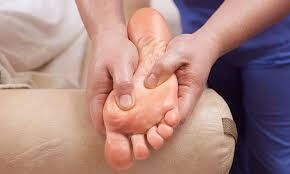Plantar Fasciitis Massage
Does Plantar Fasciitis Massage Help?
A 63-year-old female presented to the Sydney heel Pain clinic requesting plantar fasciitis massage for her painful right heel. She had been experiencing severe heel pain for more than 10 months and was becoming increasingly frustrated with her condition. She informs the sports podiatrist that she has experienced plantar fasciitis before and that it took more than two years to subside. She had read about the benefits of plantar fasciitis massage and had been treating herself at home for the last three months. She had been applying ice packs to the base of the heel and had also been rolling her foot on a frozen water bottle. None of the treatments were providing long-term relief but she did inform the podiatrist that there was short-term relief following the application of the ice packs. A work colleague informed the patient that plantar fasciitis massage is beneficial in the long term treatment of this heel pain condition. She had previously experienced soft tissue release through the calf muscle and had been using a foam roller at home in order to release the calf muscles. However, she had not paid a visit to a practitioner in order to receive specific plantar fasciitis massage.
Limited Research Around Plantar Fasciitis Massage
The sports podiatrist informed the patient that there was limited research to suggest that plantar Fasciitis massage is actually a beneficial or reliable treatment option for the condition. She was advised that a detailed assessment must be carried out in order to determine the cause of her condition and therefore which treatment or treatments would be beneficial for her particular set of circumstances. Ordinarily, the patients attending the Sydney heel Pain clinic receive other treatments that do not include plantar fasciitis massage. However, once the biomechanical assessment had been carried out a decision would be made.
The sports podiatrist performed a detailed physical assessment in order to diagnose and confirm plantar fasciitis. Firm finger pressure was applied to the plantar fascia at the attachment point on the base of the heel. Pressure was also applied through the mid arch of the foot along the distal fibres of the plantar fascia. The patient confirmed significant pain on palpation of these key points confirming plantar fasciitis.
The biomechanical assessment also revealed that the patient was using footwear that was way too soft and non-supportive. Part of her treatment plan would involve new shoes. The sports podiatrist was able to prescribe and recommend very specific makes and models of day to day shoes and running footwear. It was also revealed that the patient demonstrated restricted range of motion through the ankle joint due to tight calf muscles.
Plantar Fasciitis Massage Not Required
The sports podiatrist advised the patient that there would be no need to perform plantar fasciitis massage due to the fact that there were other contributing factors that would be addressed. Stretching the calf muscles and supporting the plantar fascia with new robust shoes would allow the plantar fascia to heal. The patient was quite pleased with these findings and agreed to this simple treatment plan. She was advised that if she continued to perform plantar fasciitis massage herself at home, then she may risk irritating the fascia, and this may cause further pain.

The sports podiatrist also explained that there were several other treatments that could be tried if there was little or no improvement. Shockwave therapy, 3-D orthotics, strapping and the use of an immobilisation boot if necessary. The patient was reviewed after three weeks and reported improvement of approximately 70%. She was happy to continue with the calf stretching and the use of the new shoes which were providing excellent support and control. She informed the sports podiatrist that she had not been carrying out plantar fasciitis massage and would be happy to continue in this fashion.
Practitioner: Karl Lockett , Sydney Heel Pain Clinic
Written by Karl Lockett





